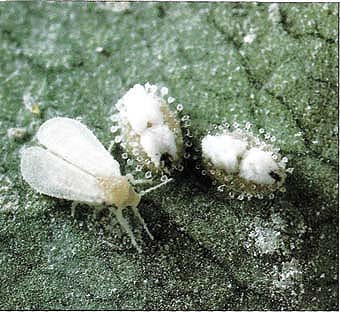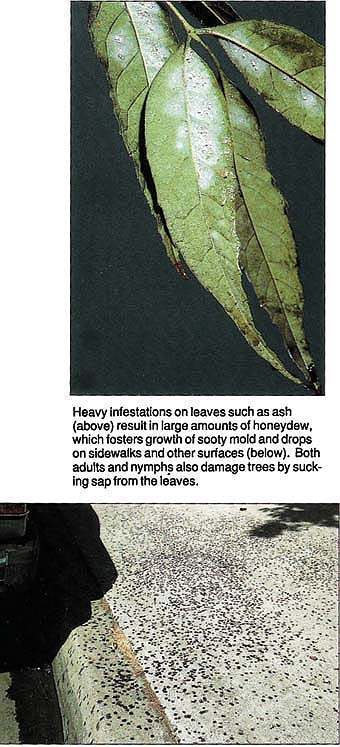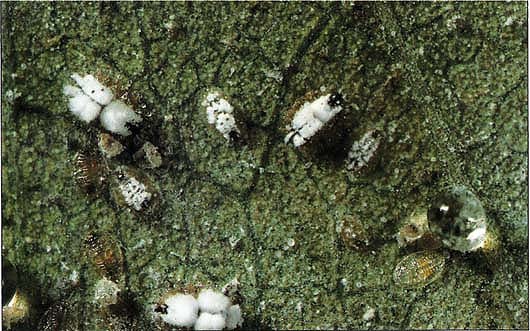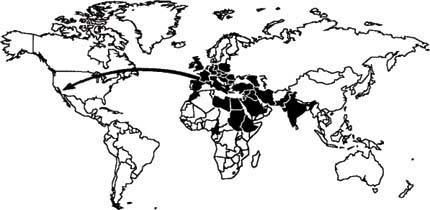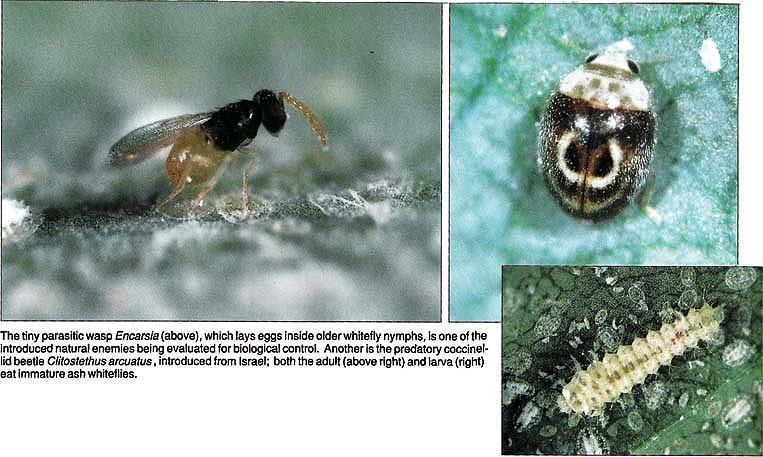All Issues
Biological control sought for ash whitefly
Publication Information
California Agriculture 44(1):4-6.
Published January 01, 1990
PDF | Citation | Permissions
Abstract
Ash whitefly has spread over a large portion of California since the initial infestation was discovered in Los Angeles County in 1988. Populations have grown to high densities on a wide range of host plants, including ash, pear, apple, citrus, and other landscape and fruit trees. The best hope for control appears to be natural enemies: a parasitic wasp and a predatory beetle have been introduced and are being evaluated.
Full text
Ash whitefly adult with two fourth-instar nymphs, or “pupae.” Beads of wax on the nymphs occur at the ends of 40 or 50 tiny siphons, or tubes, arising from the dorsal surface.
Heavy infestations on leaves such as ash (above) result in large amounts of honeydew, which fosters growth of sooty mold and drops on sidewalks and other surfaces (below). Both adults and nymphs also damage trees by sucking sap from the leaves.
Sometime in 1986 or 1987, the whitefly Siphoninus phillyreae (Halliday) was introduced into southern California, the fifth whitefly introduced in the last three decades. Dubbed the ash whitefly by Ray Gill of the California Department of Food and Agriculture, it attacks ash as well as fruit and other ornamental trees. Populations have reached extraordinary levels in Los Angeles County and may affect fruit and nursery crops throughout the state. In this report, we briefly describe the origins and scope of the infestation, the pest potential of the species, and current research toward solutions.
Origins of the problem
Siphoninus phillyreae is a palearctic species and is known from most of Europe, northern Africa, one central African country, the Middle East, southern Russia, Pakistan, and India (fig. 1). Whitefly immature stages infest leaves of plants, and ash whitefly probably entered this country with the introduction of infested plant material into the Los Angeles area, through either air or sea shipment.
The infestation was widespread when first reported and populations had reached high densities in some areas, indicating that the whitefly had been present for one or perhaps two seasons before 1988. Subsequent infestations, however, developed from just detectable levels to densities nearly equivalent to those of 1988 in Los Angeles in the span of a single season (from spring to autumn 1989) in the Riverside area.
Scope of the infestation
Following the introduction of ash whitefly into the Los Angeles area, populations developed to large numbers. The first report was in the summer of 1988. Surveys in the autumn of that year indicated that the whitefly occurred in most of Los Angeles County and also was established in western San Bernardino County.
The spring of 1989 found the ash whitefly also in Orange and Riverside counties. Subsequently it was reported throughout Los Angeles County, and is now known from San Diego, Riverside (east to the Coachella Valley), western San Bernardino, Orange, Ventura, Santa Barbara, Kern, Tulare, Santa Clara, Stanislaus, and Sacramento counties. Some of these introductions appear related to the shipment of infested material. Others may be the result of transport of whitefly adults inside vehicles, but not on foliage, from infested to uninfested areas.
Pest potential
The species has characteristics that contribute to severe pest potential. It reproduces rapidly; egg to adult developmental time is 25 days at 25°C (77°F). It passes through four nymphal stages between the egg and adult, and the adult and nymphal stages all feed by sucking plant sap from the leaves. Reproduction occurs continuously in southern California, although development is somewhat slower in the winter than in the summer. Its distribution in the Old World, from Poland and Ireland in the north to the Sudan and Ethiopia in the south, indicates that it may possess climatic tolerances that will permit its survival in many climatic zones in California.
It has been reported as a severe pest on pear and apple in Europe, often leading to substantial crop loss, but usually only when it has been introduced into areas lacking effective natural enemies. Heavy infestations have caused leaf wilt, early leaf drop, and smaller fruit. It is also reported from peach, apricot, olive, citrus, ash, and a number of other tree species. It is not generally reported as a pest in most areas except when natural enemy populations are disrupted by pesticide treatments.
In Europe and surrounding areas, the species is polyphagous, and its recorded hosts there span several plant families (table 1). In California, the ash whitefly's ability to feed on many plants and its extraordinary population growth have resulted in reports of many new host plants, some in families not previously known to host this species (table 1). In addition, different hosts are more heavily infested in some seasons than in others. During the summer and autumn, dominant hosts include ash, pomegranate, pear, and apple. Populations grow to enormous densities on these hosts, often covering 100% of the available foliage and producing substantial amounts of honeydew and sooty molds. In the autumn, as the summer hosts become dormant, populations move to other plants including citrus and the native toyon or Christmas berry.
Ash whitefly nymphs produce wax in a central strip on their dorsal surface. This is more pronounced in older (larger) nymphs, and nearly lacking in younger, semi-transparent nymphs.
The results of infestations in Europe and experience in Los Angeles County indicate that uncontrolled populations of the species are a severe threat to agriculture. Defoliation of pear has occurred repeatedly in Los Angeles County, in a few cases leading to tree death. Defoliation of citrus has occurred also. Yield reduction in less severely affected trees has been reported. Apple and pomegranate host large populations, and yield reduction in apple has been reported. Early defoliation of ash and other nonfruiting hosts has occurred.
The wide host range of the species and the number of crops that are included suggest a serious threat to nursery and fruit production industries. Most severely at risk are apple, pear, pomegranate, citrus, and shade tree nursery production. Additional fruit crops, such as plum, peach and nectarine, almond, and olive, also are vulnerable, although the degree of threat is less clear.
Research toward solutions
Whiteflies are not usually subject to successful eradication. The tools necessary for monitoring low-density populations, such as bait traps or pheromones, or for selectively treating populations, such as bait sprays, are not developed for this group of insects. Eradication of initial infestations of whiteflies has been successful only once or twice in this century, and only for relatively small infestations. The widespread infestation discovered in Los Angeles County was never seriously considered a candidate for eradication.
In the absence of eradication, research has been undertaken to develop programs for managing populations of these whiteflies. Two strategies have been employed with different objectives: pesticide treatment and biological control.
The tiny parasitic wasp Encarsia (above), which lays eggs inside older whitefly nymphs, is one of the introduced natural enemies being evaluated for biological control. Another is the predatory coccinellid beetle Clitostethus arcuatus, introduced from Israel; both the adult (above right) and larva (right) eat immature ash whiteflies.
Pesticide treatment is an option primarily against populations on nursery stock destined for shipment to noninfested areas. Several pesticides have been tested with varying results. None provided completely clean stock when applied to infested seedlings, and few provided even moderate population reduction for seven days. The general population in the environment rapidly reinfested treated material, and populations reached nontreated levels within a few days of treatment. Use of pesticides generally is not recommended for landscape trees for this reason. Mature landscape trees have withstood heavy infestations for two seasons without marked loss of vigor, although some defoliation has occurred.
The primary management approach being developed is the importation and colonizing of natural enemies of ash whitefly. Biological control has proved a successful strategy for management of many species of introduced or exotic whiteflies throughout the world, including California. Natural enemies appear to be a major force in the ecology of the pest in Europe and related areas, where it generally is not reported as reaching pest status.
Natural enemies of ash whitefly include parasitoids, predators, and diseases. Many species in these groups are well known as natural enemies of whiteflies world wide. Native whiteflies have many species of related natural enemies, but none have shown particular promise or efficiency on ash whitefly. In September 1989, natural enemies were introduced from Israel and Italy through cooperation with foreign collaborators and foreign collection by the California Department of Food and Agriculture. Eight different populations of natural enemies were introduced into quarantine at the University of California, Riverside. Thus far, only three of these have successfully reproduced: Encarsia sp. from Israel, the same species of Encarsia from Italy, and the coccinellid beetle Clitostethus arcuatus (Rossi).
The Encarsia species reproduce by laying eggs inside late nymphal instars of the whitefly. The larval wasp consumes the whitefly and emerges as an adult in about 23 days at 25°C (77°F). The adult wasp probably feeds on honeydew and possibly also on whitefly nymphs. Clitostethus arcuatus develops from egg to adult in about 25 days at 20°C (70°F). Both the adults and larvae of the beetle feed on ash whitefly nymphs. Such native generalist predators as lacewings and syrphid larvae do not appear to be having any significant effect on whitefly populations.
The beetle population is still being reared in quarantine awaiting the outcome of further trials before field release. Quarantine trials for the two Encarsia species were completed in October, and subsequently colonies of the two species were expanded. The two populations are currently in separate colonies. These have been released in five southern California counties for initial tests for establishment. The results of these trials should be available early in the spring of 1990, although recoveries have already been made in Riverside County. These beneficial insects will be evaluated against the ash whitefly in California during continued releases early next year. Additional agents will be imported as necessary to effect adequate biological control throughout California.
The ash whitefly project is a multi-agency program involving the University of California, the California Department of Food and Agriculture, and the California Agricultural Commissioners' Biological Control Committee. Participants are conducting research and development of solutions for controlling this species. We also anticipate research toward implementation of statewide release and establishment of beneficial insects as they become available. The first step in this portion of the program is rearing, now under way, for large-scale trial releases planned for the spring of 1990. These studies will determine the relative effectiveness of different release tactics, such as numbers released, timing of releases, and need for subsequent releases, in anticipation of major rearing and releases throughout the state in the following months.



